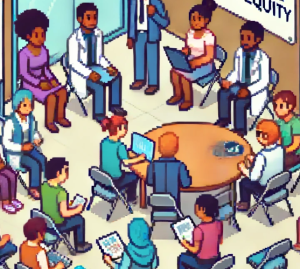
Tripping Over the Truth: A Journey to Implementation Excellence
An interview with Jenice Pizzuto of Impact, Lead, Succeed.
“Learning is my fuel! Helping people get better at getting better is my thing, and I do it using science and human and learning-centered design. Change is hard—asking people involved in the change to change behaviors is even harder.”

Jenice Pizzuto is a systems, change, and implementation expert, and the founder of IMPACT Lead Succeed. With extensive experience as a speaker, facilitator, consultant, administrator, and educator, she brings a wealth of knowledge and a commitment to continuous improvement. Jenice serves on the Board of Directors for the Global Implementation Society (GIS), where she was a founding member and chaired the Professional Learning and Resources Committee.
Jenice recently authored Implement with IMPACT, so we asked her about its implications for public health.
What inspired you to write this book?
I wrote Implement with IMPACT to help ‘stop the madness.’ Stop the madness of the adopt-and-abandon cycle prevalent across health, education, and social welfare sectors. After years of witnessing the haphazard implementation of evidence-based practices (EBP), I was frustrated. Despite decades of research on what an EBP will do, we continue to fail to successfully implement these innovations. I knew we had a severe problem, a problem translating the science to the people who need it—a problem of getting change done right and well. I tripped over the truth. Dan and Chip Heath describe that moment when you trip over the truth as;
When you have a sudden realization, one that you didn’t see coming, and one that you know viscerally is right, you’ve tripped over the truth. It’s a defining moment that in an instant can change the way you see the world.
—Chip Heath and Dan Heath
My defining moment of tripping over the truth was understanding that there is a better way to get evidence-based interventions/innovations to the people who need them. I knew implementation science alone was insufficient to get the EBP’s in place with fidelity across many sectors, especially education. Understanding this changed the way I see the world, and I began my quest to write a book that would be an accessible and approachable guide that provides practical strategies for leaders to implement change effectively in their organizations. I wanted to offer actionable insights and tools to help leaders navigate the complexities of change management, drive impactful results, and apply implementation science and human and learning-centered design to scale effectively.
Years of research and experience in implementation and improvement science, behavior change, professional learning, andragogy, and the science of teams led to the development of the IMPACT Implementation Framework©. The book and framework aim to provide busy leaders with accessible and reliable resources and tools to help organizations improve their use of implementation science.
What lessons learned from school evaluations can be applied to public health settings?
Implementing change across all sectors is quite challenging. I have worked with non-profits, businesses, social welfare agencies, and the education sector. What each has in common is that each needs to build what I call the K.S.A.s of their people, understand that change is a process, not an event, and facilitate strategic implementation using a collaborative approach.
- Knowledge-understand, Why, What and How of the EBP
- Skills-be able to competently and confidently perform the new behaviors associated with the EBP successfully at least 80% of the time.
- Attitudes-believe in the ‘Why’ of the change, apply a learning and improvement mindset
Change is a process, not an event. Like any complex process, leading the change associated with implementing an evidence-based innovation involves a deep understanding of why the innovation is needed; what skills, knowledge, attitudes, and beliefs need to be developed and by whom; and what processes are needed to facilitate and solicit the required change within the organization, team, and individuals. However, even if the purpose is clear and professional learning opportunities are provided, belief won’t always follow. And without the belief that the change is needed and will be effective, the required change won’t last, and the implementation gap will remain. Embracing the need for change is an essential first step of the implementation process.
Managing the complexity of change and facilitating strategic implementation requires a collaborative approach to leadership. They require, as leadership expert Michael Fullan (2016) calls it, shared leadership. Shared leadership shows up in the field of implementation science in the form of the implementation team. Lessons learned include utilizing an implementation team to manage the change process. This implementation team benefits from utilizing not only implementation science but also change and human and learning-centered design elements.
You work deeply with the Global Implementation Society. Can you talk about your work and goals in this area?
The GIS promotes the development and integration of effective implementation, improvement, and scaling practices in human service settings in order to improve outcomes for children, families, individuals, and communities worldwide. I am honored to serve on the Board of Directors. I am a founding member of the Global Implementation Society, served on the Professional Learning and Resources (PLR) committee, and then chaired the PLR before being elected to the board of directors. GIS is sector-agnostic and focused on uplifting, connecting, collaborating with, and engaging implementation science enthusiasts from across the globe. We are unique in that the organization is driven to engage not only experts in implementation science but also practitioners, implementers, researchers, and policymakers.
My work with the Global Implementation Society is driven by my moral imperative to build implementation literacy globally to impact outcomes and scale EBPs to improve human social and emotional well-being.
Is there a secret ingredient to implementation? If so, what is it?
Yes, actually there is a secret ingredient to implementation! Include the people involved in the change in the design of the change. Utilize human and learning-centered design elements in your implementation design.
Shift the culture. Shift away from adopting and abandoning, blaming and shaming, and chasing the latest fad or shiny object and toward effectively implementing evidence-based practices.
The purpose is to build implementer knowledge, skills, attitudes, and competence they need to get change done right and well and to build a culture centered on:
- Effective implementation
- Human elements of change
- Adult learning
- Growth and improvement
In short, the culture centers on implementation through deliberate growth. In my book, we call this Deliberately Developmental Implementation, DDI. Use DDI to support your staff to and through the
implementation effort by utilizing an implementation team, an implementation framework, such as the IMPACT Implementation Framewrk©, and an implementation planning template, such as the IMPACT Implementation Planning Template©, and adopting a change theory, such as the COM-B or the Knoster Change Process.
It’s a pivot election year in the US. How do you see implementation science informing policy going forward?
This is a fantastic question!
While we face tumultuous political cycles globally, I believe we, as leaders in change, should remain focused on continuing to do the work because it matters more now than ever. Instead of being distracted, we must engage in getting evidence-based practices to those who need them. We can actively write, seek out, and contribute to grants that affect policy and research. We can advocate for utilizing deliberately developmental implementation (DDI), including implementers in the design of the implementation, utilizing implementation teams, and shifting the culture away from shame and blame to learning and improvement.
When we continue to push forward to get implementation science and human and learning-centered design elements in public policy globally, we begin to impact socially intransigent issues. By doing the work, we learn the work- and make a difference. My answer the question is: do the work, impact outcomes, and inform the policy. Advocate for including implementers in implementation efforts, embed implementation plans, and scaling results into grant-funded research and policy. Do this with a learning and improvement mindset! Look at failures as an opportunity to learn and then iterate!
Additional Reading
Fullan, M. (2016). The new meaning of educational change (5th ed.). New York: Teachers College Press.
Heath, C., & Heath, D. (2017). The power of moments: Why certain experiences have extraordinary impact. New York: Simon & Schuster.
Be Part of the Change – Get Weekly Updates!
Stay informed and connected. Subscribe for free and share this blog to make a difference in public health with others.



